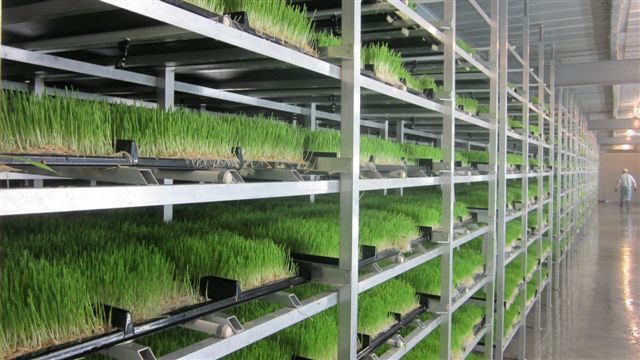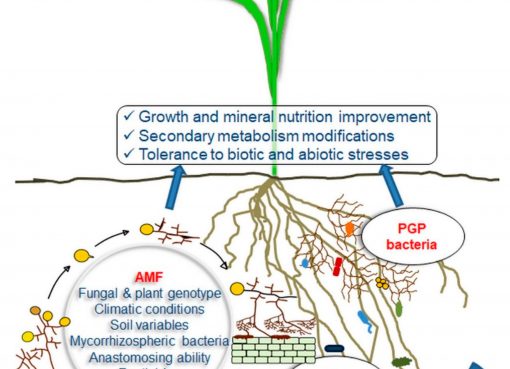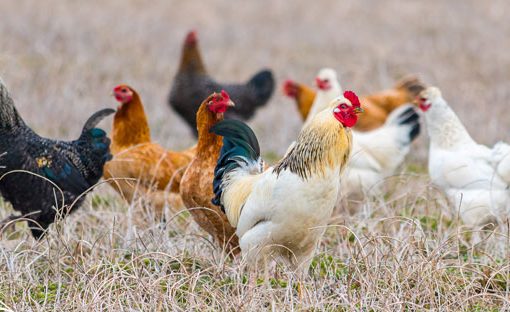HYDROPONICS GREEN FODDER PRODUCTION
The term Hydroponics was derived from the Greek words “hydro” meaning “water” and “ponos” meaning labour. It is a method of growing plants using mineral nutrient solutions, without soil. It is a science of growing plants in nutrient rich solutions instead of soil and can be efficiently used to take pressure off the land to grow green feed for the livestock. Plants require three things to flourish, water, nutrients and sunlight. Hydroponics is a straight forward way of providing all these nutrients without the need of soil under controlled environmental conditions to optimize the growth of plants. The technology has been tested on various crops as Maize, Sorghum, Barley, Oats etc. for producing high quality of nutritious green fodder for dairy animals. Beside this, hydroponics can be used for growing wheat grass, paddy saplings, etc. in seven days time for optimum growth. Fodder obtained from hydroponics consists of grass with grains, roots, stem and leaves compared to only stem and leaves parts in conventionally grown fodder.
Importance of Green Fodder:
Green Fodders are Natural diet for animals. It improves fat percentage in milk. Green fodders are rich in beta carotene and help in synthesis of vitamin A, which has greater impact on reproduction. Green fodder is an essential component of the dairy ration; otherwise, the productive and the reproductive performances of dairy animals are adversely affected. Therefore, for a sustainable dairy farming, quality green fodder should be fed regularly to the dairy animals (Naik et al., 2012). Green Fodder replaces 13-35% of the total input cost of the total cost (70 to 75%). Green fodder supply round the year is required for good dairy practices.
Advantages of hydroponics culture:
There are many advantages of growing plants under soil-less culture over soil-based culture (Savvas, 2002). These gardens produce the healthiest crops with high yields and are consistently reliable; gardening is clean and extremely easy, requiring very little effort (Silberbush and Ben-Asher, 2001). Here nutrients are fed directly to the roots; as a result plants grow faster with smaller roots. Plants may be grown closer and only 1/5th of overall space and 1/20th of total water is needed to grow plants under soil-less culture in comparison to soil-based culture (Silberbush and Ben-Asher, 2001). There is no chance of soil-borne insect pests, disease attack or weed infestation too. Overall, soil-less culture provides efficient nutrient regulation and higher density planting, leading to increased yield per acre along with better quality of the produce. It is also effective for the regions of the world having scarcity of arable or fertile land for agriculture (Sonneveld, 2000).
When removed from soil, root tissue is often mechanically sheared causing loss or damage of tissue. This is particularly true for fine root structures such as lateral roots and root hairs. Hydroponic systems that do not utilize an inert particulate media allow a less invasive separation of root and shoot tissues. In soil systems, nutrient bioavailability changes throughout the soil matrix as nutrients bind to soil particles creating micro-environments within the soil. This heterogeneity could add an extra level of complexity in experiments needing a precise control on the external concentration of nutrients or other molecules. In contrast, the hydroponic solution is homogeneous and can be easily replaced throughout the course of the experiment (Nguyen et. al., 2016).
Nutrients are not wasted or leached away. Nutrients supplied to the plants can be controlled. Crop yields and plant growths are consistent. Hydroponics also conserves water leading to no crop rotation, thus more plants can be grown in a smaller area (Berndsen and Gardener, 2014).
Limitations of soil-less culture:
- Application on commercial scale requires technical knowledge and high initial investment, though returns are high (Sonneveld, 2000).
- Considering the high cost, the soil-less culture is limited to high value crops. Great care is required with respect to plant health control. Finally, energy inputs are necessary to run the system (Van Os et al., 2002).
- Initial high cost of setting up the system. It also requires regular monitoring of nutrient solutions
- Specially trained personnel are required (Berndsen and Gardener, 2014).
- Although hydroponic cultures offer clear advantages over soil-based systems, there are some considerations that must be acknowledged when interpreting the data. For instance, hydroponic systems expose plants to conditions that may be seen as non-physiological. Therefore, phenotypes or plant responses detected using hydroponic systems may vary in magnitude when plants are grown in alternative systems (e.g., soil or agar-based media). These considerations are not unique for hydroponic systems; differential responses can also be observed if plants are grown in different types of soil (Nguyen, 2016).
Protocol for hydroponics Seed Production:
- Add a 5-7 liters warm water in a plastic bucket and seed and remove seeds are float on the water because they will not sprout also remove other impurities.
- After that add 50 -100 gm salt in water; it helps to minimize chance on fungus production on sprouted seed.
- Allow this seed to soak water for around 12 hours.
- After 12 hours, drain the water and then wash the seeds with clean water.
- Transfer this washed seed in a gunny bag and allow them to sprout. In a cold climate, they will take more than 24 hours to germinate while in a hot climate the seed will take about 24 hours.
- Before using trays, wash them properly and check all holes are if they are blocked or not; if there is blockage, remove the blockage.
- Transfer sprouted seeds from the gunny bags to trays and evenly spread them and place the trays on the rack.
- Every day give light water (sprinkle) to sprouted seeds. To provide water, we can use watering cans or sprinklers system. In hot weather conditions, give water after every two hours, and in cold weather condition, after 4 hours; it helps to maintain moisture. Always maintain cleanliness in the shed; it helps to reduce the chance of fungus, molds
- Do not disturb the sprouted seeds from the trays until they are harvested as this influences the growth of the fodder.
Protocol for Hydroponic Fodder Production:
Seed storage and preparation: Dry the seeds under direct sunlight one day prior to seed washing. Remove broken seeds and dirt from the seeds. Store seeds in a dry and safe place.
Seed washing: Take good quality seeds in a washing chamber. Add water. Wash the seeds with proper scrubbing by hand. Keep for settling for 5 minutes. Remove the light weight floating seeds. Drain out water and again add water. Stir manually by wooden stick for 5 minutes, keep settling for 5 minutes. Drain water. Repeat the above steps till, dirt and dead seeds are removed completely. Seed cleaning: Prepare 0.1% cleaning solution in a plastic chamber as given in the table below. Add washed seeds to this 0.1% cleaning solution. Stir manually by wooden stick for about 5 minutes. Keep for 1 hour drain the cleaning solution.
Seed soaking: Add seeds from the above steps to the soaking chamber. Close the lid and keep for soaking for number of hours as given in the table below for the given seeds. After soaking for the given hours, drain the stimulant solution.
Seed germination: Cover/ place the “After soaking seeds” with the clean dry fumigated gunny bag. Keep the seeds loaded gunny bags away from direct sunlight. Keep the lid open and keep for germination for number of hours. Sprinkle water on gunny bag every 2-3 hours so that the gunny bag remains wet. After given hours, remove the seeds from gunny bag take weight. About 35 to 40% increase in weight happen with about 90+% seed germination.
Loading seeds in trays and racking: Ensure that the trays are clean, washed with cleaning solution and are free from any dust / dirt etc. Transfer “after germination seeds” on the trays equally and put them in the sprout section (lower section where the height between two rows is around 5 inches) of machine. Trays should be distributed evenly on both sides of the alley.
Shifting of trays: Shift trays to the next level daily so that they move one step ahead in the growth cycle. Take the last tray out from every row and put it back on the front side of the same row. Ensure that all trays are moved one position every day. Ensure that all trays receive sufficient water. If left side of the tray (in any tray) shows more growth, then the right side (or vice-versa) then rotates the tray such that left side comes to the right side and right side of the tray goes to the left side.
Harvesting (Day 9): The trays on the 8th day rack become ready for harvesting on the next day. Take out of the fodder mat from trays to feed livestock. Wash the trays in clean water and then in cleaning solution before reusing it for the next cycle.
References:
- Naik, P.K.; Dhuri, R.B.; Karunakaran, M. Swain, B.K. and Singh, N.P. (2013). Hydroponics technology for green fodder production. Indian Dairyman. 65: 54-58.
- Nguyen, N.T.; McInturf, S.A. and Mendoza-Cózatl, D.G. (2016). Hydroponics: A Versatile System to Study Nutrient Allocation and Plant Responses to Nutrient Availability and Exposure to Toxic Elements. Vis. Exp.113: e54317, doi:10.3791/54317.
- Savvas, D. (2002). Nutrient solution recycling in hydroponics. In: HydroponicProduc tion of Vegetables and Ornamentals (Savvas, D., Passam, H. C., eds.), pp. 299–343. Embryo Publications, Athens, Greece.
- Silberbush, M. and Ben-Asher, J. (2001). Simulation study of nutrient uptake by plants from soilless cultures as affected by salinity buildup and transpiration. Plant and Soil., 233: 59–69.
- Sonneveld, C. (2000). Effects of salinity on substrate grown vegetables and ornamentals in greenhouse horticulture. PhDThesis, University of Wageningen, The Netherlands.
- Van, Os E. A.; Gieling, Th. H. and Ruijs, M. N. A. (2002). Equipment for hydroponicinstallations. In: Hydroponic Production of Vegetables and Ornamentals (Savvas, D; Passam, H. C., eds), pp. 103–141. Embryo Publications, Athens, Greece.
Designation of Author/Authors: Dr. Mamata Joysowal, Assistant Professor,
Department of Animal Nutrition
Email ID of Author/Authors: Mamtajaiswal525@gmail.com
Name of Institute: College of Veterinary Science, AAU, Khanapara, Guwahati-22, Assam




